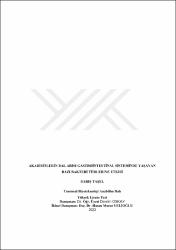| dc.contributor.advisor | Oskay, Devrim | |
| dc.contributor.advisor | Velioğlu, Hasan Murat | |
| dc.contributor.author | Taşel, Barış | |
| dc.date.accessioned | 2023-04-27T20:40:51Z | |
| dc.date.available | 2023-04-27T20:40:51Z | |
| dc.date.issued | 2023 | |
| dc.identifier.uri | https://tez.yok.gov.tr/UlusalTezMerkezi/TezGoster?key=r4I1HnmXxFQovUpyAyUmxMfZlwumzeI5zas3OLW8AaZ2bDzHq-1qhuZ8SpYAOVIJ | |
| dc.identifier.uri | https://hdl.handle.net/20.500.11776/11397 | |
| dc.description.abstract | Varroa akarı dünya üzerinde, arıcılık sektöründe önemli ekonomik kayıpların verilmesine neden olmaya devam etmektedir. Akarla mücadelede geliştirilen stratejilerden birisi de kolonilere sentetik akarasit kullanımıdır. Bal arısı mikrobiyotası, patojenlere karşı savunmada, metabolizmanın çalışmasında, verimde, bağışıklık sisteminin, vücudun ve davranışın gelişmesinde önemli rol oynar. Bu tezde bal arısı gastrointestinal sisteminden izole edilen bakteri türlerinin genetik tanımlaması yapılmıştır ve üzerinde akarisitlerin disk difüzyon tekniği ile antimikrobiyal aktivitesi araştırılmıştır. Bu amaçla piyasada bulunan amitraz, flumethrin ve tau-fluvalinate içeren akarisitlerin 1/1, 1/2, 1/4, 1/8, 1/16, 1/32 dozlarının antimikrobiyal aktivitesi istatistiki olarak değerlendirilmiştir. Çalışmalar 3 tekerrür olarak uygulanmıştır. Amitraz, Lactiplantibacillus spp. üzerinde sırası ile 14,96 mm, 14,43 mm, 13,56 mm, 11,46 mm, 10,13 mm, 7,66 mm inhibisyon zon çapı oluşturmuştur. Leuconostoc mesenteroides üzerine sırası ile 17,83 mm, 16,56 mm, 12,93mm, 8,70 mm inhibisyon zon çapı oluşturmuştur. Bifidobacterium spp. üzerinde sırası ile 15,36 mm, 14,43 mm, 13,50 mm, 12,26mm, 10,23 mm inhibisyon zon çapı oluşturmuştur. Amitrazın, Klebsiella aerogenes ve Citrobacter freundii üzerinde herhangi bir antimikrobiyal aktivitesi görülmemiştir. Flumethrin ve tau-fluvalinate içeren akarisitlerin ise test edilen bakterilerin tümünde herhangi bir antimikrobiyal aktivitesi saptanmamıştır. Bu çalışmada, amitraz etken maddeli akarisitlerin bal arısı gastrointestinal sistemindeki bazı laktik asit bakterilerine antimikrobiyal etkisi olduğu tespit edilmiştir. Gelecekte arıcılıkta varroa akarına karşı kullanılan akarisitlerin bal arısı mikrobiyotasındaki etkilerinin daha geniş kapsamda araştırılması, ortaya çıkan olumsuz etkilere karşı yeni stratejilerin geliştirilmesine ışık tutulması gerekliliği görülmektedir. | en_US |
| dc.description.abstract | Varroa mite continues to inflict substantial economic losses in the global beekeeping sector. In colonies, the use of synthetic acaricides is one of the strategies explored in the combat against mites. The microbiota of honeybees have a crucial role in pathogen protection, metabolism, efficiency, development of the immune system, body, and behavior. In this dissertation, the genetic identification of bacterial species isolated from the digestive tract of honey bees and the antibacterial activity of acaricides were examined using the disc diffusion method. The antibacterial activity of 1/1, 1/2, 1/4, 1/8, 1/16, and 1/32 dosages of acaricides including amitraz, flumethrin, and tau-fluvalinate was statistically tested for this purpose. There were three replications of the experiments. On Lactiplantibacillus spp., the inhibition zone diameter of Amitraz was 14.96 mm, 14.43 mm, 13.56 mm, 11.46 mm, 10.13 mm, and 7.66 mm, respectively. On Leuconostoc mesenteroides, inhibition zone sizes of 17.83 mm, 16.56 mm, 12.93 mm, and 8.70 mm were generated, respectively. On Bifidobacterium spp., the inhibition zone diameters were 15.36 mm, 14.43 mm, 13.50 mm, 12.26 mm, and 10.23 mm, respectively. Klebsiella aerogenes and Citrobacter freundii exhibited no antibacterial action against amitraz. Flumethrin and tau-fluvalinate-containing acaricides exhibited no antibacterial action against all tested microorganisms. In this research, it was discovered that acaricides containing amitraz had an antibacterial impact on some lactic acid bacteria in the honeybee digestive system. Future research must explore the impact of acaricides used against varroa mite in beekeeping on the honeybee microbiome in more detail and offer information on the creation of new strategies to combat the increasing negative effects. | en_US |
| dc.language.iso | tur | en_US |
| dc.publisher | Tekirdağ Namık Kemal Üniversitesi | en_US |
| dc.rights | info:eu-repo/semantics/openAccess | en_US |
| dc.subject | Bal arıları,varroa,bakteri | en_US |
| dc.subject | amitaz | en_US |
| dc.subject | flumethrin,tau-fluvalinate,disk difüzyon | en_US |
| dc.subject | Honey bees | en_US |
| dc.subject | varroa | en_US |
| dc.subject | bacteria | en_US |
| dc.subject | amitraz | en_US |
| dc.subject | flumethrin | en_US |
| dc.subject | tau-fluvalinate | en_US |
| dc.subject | disc diffusion | en_US |
| dc.subject | Biyoteknoloji | en_US |
| dc.subject | Biotechnology | en_US |
| dc.subject | Mikrobiyoloji | en_US |
| dc.subject | Microbiology | en_US |
| dc.subject | Ziraat | en_US |
| dc.subject | Agriculture | en_US |
| dc.title | Akarisitlerin bal arısı gastrointestinal sisteminde yaşayan bazı bakteri türlerine etkisi | en_US |
| dc.title.alternative | The effect of acaricides on some bacteria species live in the honey bee gastrointestinal system | en_US |
| dc.type | masterThesis | en_US |
| dc.department | Enstitüler, Fen Bilimleri Enstitüsü, Tarımsal Biyoteknoloji Ana Bilim Dalı | en_US |
| dc.identifier.startpage | 1 | en_US |
| dc.identifier.endpage | 68 | en_US |
| dc.institutionauthor | Taşel, Barış | |
| dc.relation.publicationcategory | Tez | en_US |
| dc.identifier.yoktezid | 785620 | en_US |



















